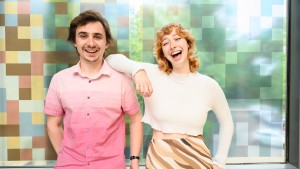The decisions for the U.S. National Science Foundation’s Graduate Research Fellowship Program came out one morning in early April. For Phillip Diamond ’24, the email came through while waiting in line for breakfast at Peirce. Jonah Dominguez ’22 was first clued into his win by a friend, who’d texted him six exclamation points at 1 a.m.. And for Freya Beinart ’24, the email’s timing was especially celebratory: “It was the day before my birthday. So it was a really great early birthday present.”
The early morning emails spelled success for these three Kenyon community members, two of whom just graduated May 18. The prestigious five-year fellowship, rare for undergraduates to receive, provides three years of financial support — a game-changer in any Ph.D. program. For all three, the wins came as a total surprise.
“The application was due in October. So it was definitely out of sight, out of mind for such a long time,” said Beinart, who majored in molecular biology and Arabic. The challenge of the application lies in describing both previous research experience and envisioning one’s graduate-level research holistically. “You have to [think about] the past and future for so many different categories,” Dominguez, a Ph.D. student at University of Illinois Champaign-Urbana researching how different bird species interact, noted.
For Diamond, the fellowship affected not only his research planning, but finding the right graduate experience. Winning the fellowship allowed him to be reconsidered and eventually accepted at University of Illinois Champaign-Urbana, where he had previously had applied to the Ph.D. program in physics.
The path to a NSF fellowship win was not straightforward for any of the three.
“I came into Kenyon not really knowing what I wanted to do,” said Diamond, a math major who won a Goldwater Scholarship in 2023. On the advice of a fellow STEM Scholar (both he and Beinart were in the program), Diamond reached out to professors and began getting involved in research. A summer science collaboration with Professor of Physics Benjamin Schumacher sparked a bond, forged by “thinking about hard things” and bouts of wordplay.
“Recently I chatted with him and we were talking about how you change as a person so much over time that you could go back and view your past self as a different person. And I was like, ‘Oh, so it's the ship of me-seus,’” (referencing the ‘Ship of Theseus’ paradox that questions whether an object is still the same after having all of its parts replaced.)
Regardless of one’s stance on that particular thought experiment, Beinart, Diamond and Dominguez all mentioned the transformative experience of working with professors on research at Kenyon.
“It's definitely helped me a lot, working with professors at Kenyon and learning to become an independent researcher and then taking these opportunities at other institutions to broaden my skills,” said Beinart, who’s headed to Washington University School of Medicine in St. Louis this fall as a biochemistry, biophysics, and structural biology doctoral candidate. Beinart credits Assistant Professor of Biology Kathy Gillen for boosting her confidence and ability to explore new areas of research. “She lets me be independent, but she's always there if I need any help.”
While birds have long been a point of interest for Dominguez — he’s been hooked since high school, when his family began keeping chickens and his mother asked him to help research different breeds — undergraduate work with Assistant Professor of Biology Natalie Wright helped him refine his area of interest and realize his passion for field work. A chance dinner party conversation during the early days of his PhD led to his current research area of focus. “We were just chatting about birds responding to alarm calls that they hadn't heard before. And I was like, “I have time to kill. Could I help?” And my research has continued from that, looking at how alarm calls in mixed-species flocks function.”
As for Beinart and Diamond, they’re saying goodbye to Kenyon and anticipating grad school with mixed emotions. “I feel prepared,” said Beinart. “With the grad school environment, there's only 13 people in my cohort, so sometimes it's going to feel like a small school like Kenyon.”
“I've heard a lot of scary stories about physics grad school, so I know it will be difficult and that I'm putting myself in a difficult place,” said Diamond, who majored in mathematics at Kenyon. “But I'm justifying that by telling myself that this is the time in my life that I can learn the most and be around people that are learning a lot. So I don't feel prepared, but I'm not scared and I welcome the challenge.”
